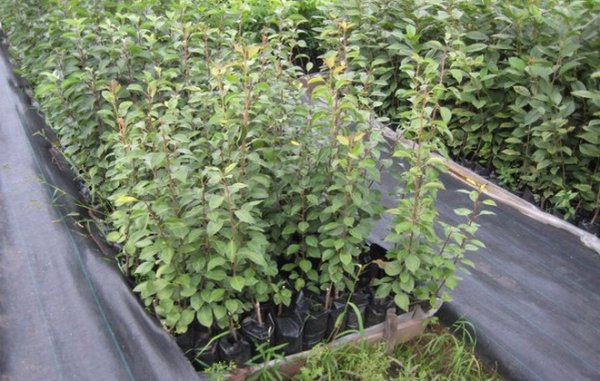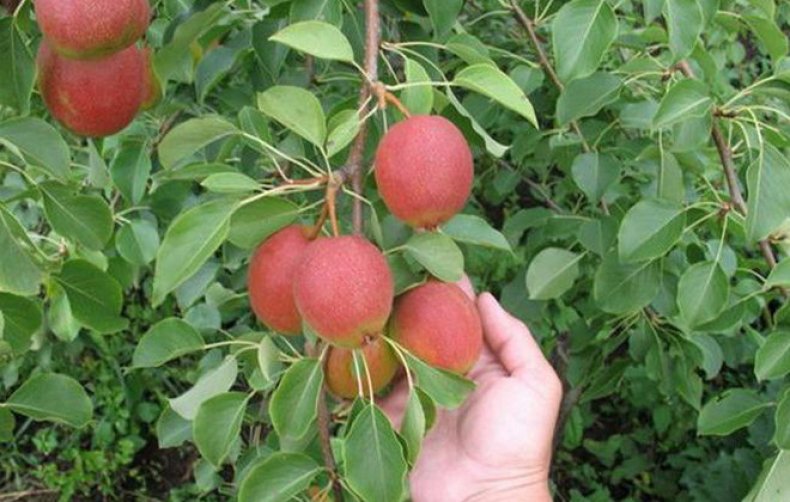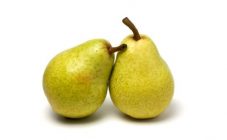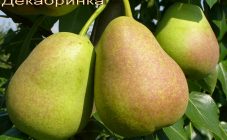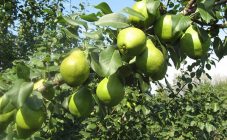Content:
Pear Krasulia is a fast-growing, early summer culture. It was bred at the Research Institute of Fruit and Potato Growing (GNU YUNIIPOK) in Chelyabinsk, South Ural Region, by the outstanding scientist-breeder E. A. Falkenberg. The variety was obtained by crossing the Black with Little Joy. In 1987, the seedling was included in the list of elite varieties, and in 2002 the Krasulia pear was included in the State Register of Russia and recommended for cultivation for the Ural, West Siberian region.
Description of Krasulia pear
According to its characteristics, the tree is distinguished by its average vigor. An adult specimen reaches a height of 4 m. The crown is round, spreading, brown. The branches are compact, straight (when they leave the trunk, they form an angle of 90 °), grow with the ends up.
The trunk is conical, slightly twisted. The bark of the trunk, skeletal branches is greenish, characterized by characteristic peeling.
Mixed fruiting is carried out on ringlets, short fruit twigs, last year's growths. Shoots are brown, straight, even, fleecy. Leaves are medium in size, wide, rounded, dark green, with yellow veins. Young foliage of light green color. The leaf plates are not lowered, bent towards the bottom. The edges are finely toothed, the tips are shortly pointed. Petioles are thick, long, drooping, covered with pile. Stipules are large, lanceolate.
This culture belongs to the partially self-fertile varieties. She can bear fruit herself, although the yields will be quite average. The best pollinators for her are:
- pear Severyanka;
- pear rainbow.
Krasulia blooms in the middle (15-20) May. The flower buds are large, slightly elongated. Flowers are large, white, fragrant, chalky. The petals are oval. Medium pistils. The stigmas are located at the level of the anthers.
Fruits are round, oval-flattened medium in size, reminiscent of bergamot in shape. The weight of one pear is 90-120 g. The skin is delicate, soft, oily, smooth, glossy, through it many gray subcutaneous dots are clearly visible.
Peduncles are short, straight. On the underside of the fruit, instead of a funnel, there are outgrowths of indefinite shapes, which is considered a varietal feature of the Krasul pear. The seed box is small, half open. The sub-calyx tube is long and narrow. Seeds are large, wide, dark brown.
The pulp is creamy, slightly oily, tender, loose, juicy, aromatic, very sweet in taste. Has a pleasant aftertaste.
The tasting score on a five-point scale is high - 4.7 points. Krasulia pears are tastier than the fruits of the Red-cheeked variety (brought from the Nikitsky Botanical Garden).
Chemical composition:
- sugar - 11.2%;
- dry matter - 13%;
- titratable acids - 0.49%;
- ascorbic acid - 8.5 mg / 100 g.
The fruits are consumed fresh, they are used for making jam, compotes, juices. Unfortunately the variety is not suitable for commercial purposes. Fruits are not stored for a long time (only 10-12 days). In the refrigerator - 2 weeks. Poorly tolerated transportation.
The Krasulia variety is fast-growing, begins to bear fruit after planting a seedling for 4-5 years. Fruiting of the tree is stable. Differs in high productivity.At the age of 10 years, the tree can produce up to 40 kg of fruit. Pears ripen in the first half of August. For comparison: Severyanka ripens 7 days later.
The culture has high winter hardiness, tolerates frost, cold, bad weather well. Resistant to scab, bacterial burns, pear gall mites, fungal infections.
The Krasulia variety is propagated by grafting on the seedlings of Ussuri pears.
Landing
A site for a plant should be chosen open, sunny, well-lit, with loose fertile soil. In addition, it must be protected from the wind. The Krasulia pear tree is not demanding on the soil. It can grow on black earth, sandy, clayey lands. However, wetlands should be avoided.
Gardeners need to keep in mind that the tree, due to its spreading crown, prefers to grow separately from other crops. The distance between them should be at least 5 m. If you plan to plant a pear next to the building, then you need to retreat from the building 3 m. Also, do not plant a tree under large plants. They will hide it from the sunlight.
In the northern regions, planting is carried out when the threat of return frosts has passed (mid-April - early May). In the southern territories, a plant is planted both in spring and autumn (late September - early November).
Experienced gardeners recommend choosing fruit trees with a good root system, from 2 years old. Before planting the plant, its roots are immersed in a solution of potassium permanganate. This will disinfect them, save them from many diseases.
Planting scheme
- The hole is prepared in advance. They make a depth of 60 cm, a diameter of 100 cm (the size depends on the roots).
- Sawdust, small stones, a little soil are laid at the bottom of the pit. Pour 1 bucket of water. You need to wait for it to be absorbed.
- The dug soil is mixed with humus, you can add a liter can of ash.
- The plant is placed in a hole. The roots are carefully spread.
- Sprinkle with earth, tamp. Water (2-3 buckets of water). The stem of the pear is tied to an installed peg.
- Mulch the ground around the trunk.
- A day later, the tree is watered again (1-2 buckets of water).
Further care
No special efforts are required from the gardener. Everything is standard:
- Particular attention should be paid to young seedlings. After 3-5 years, all the necessary measures are carried out as needed.
- Watering Krasula once a week (2-3 buckets of water). In dry weather, at least 2-3 times. Also, irrigation is carried out during the flowering of the tree, the ripening of the fruits. Each time after watering, the soil is loosened, mulched with peat.
- The plant is fed annually in early spring (nitrogen composition, urea), during the budding period (phosphorus fertilizers, wood ash). In the summer, they use water-diluted chicken manure, slurry, and in the fall, phosphate-potassium substances.
- The Krasulia variety requires annual pruning. The primary work needs to be done after planting the tree. The shoots of the main branches are shortened by a third. This will enhance their growth. Sick, broken, damaged branches are also removed. The procedure is carried out in the spring, in the fall as required.
- In the spring and autumn, the orchard is cleaned of fallen leaves, dry grass, dug up near-stem circles, whitewash the trunks.
Pests and diseases
If the tree is affected by diseases and insects, then medical and preventive procedures are carried out. Insecticides, fungicides are used in the spring-autumn period. In the summer, biological products, folk remedies (infusions of garlic, marigolds, tomato tops) are used. You have to fight with the following:
- The pear mite lives in the bark, kidney scales, and appears in the spring. To remove it, the tree is treated with colloidal sulfur.
- The pear moth is a butterfly that lays eggs on leaves. In summer, caterpillars appear, eating the fruits. They use the drug kinmix or agravertin against them. Pollination with chemicals must be done at least 2 times a season until the leaves bloom, as well as before flowering.
- Leafworm. For the fight use infusion of tobacco.
- The green aphid promotes the development of a sooty fungus. To eliminate it, the plant is sprayed before the leaves bloom, before flowering, before the fruit is formed. A spark, kinmix will do.
- Powdery mildew can kill 70% of the crop. To avoid its appearance, spray with colloidal sulfur at least 3 times (every 14 days).
- Fruit rot. It is treated with Bordeaux liquid. In the fall, after the harvest, with urea.
- Rust. To prevent it, spray with a solution of ash and soap (before flowering).
- Cytosporosis. Treatment with copper sulfate helps from the disease.
Advantages and disadvantages of the variety
Advantages:
- excellent immunity;
- you can grow a pear in regions with difficult climatic conditions;
- the culture bears fruit stably, has a high yield;
- good taste, attractive appearance (which is why the variety was named Krasulia).
Disadvantages:
- small fruits;
- low shelf life of fruits;
- available thorns in the crown.
Despite minor drawbacks, the Krasul pear variety is popular with gardeners. He is loved for productivity, unpretentiousness in care, resistance to diseases. It is grown both in summer cottages and in industrial production.

